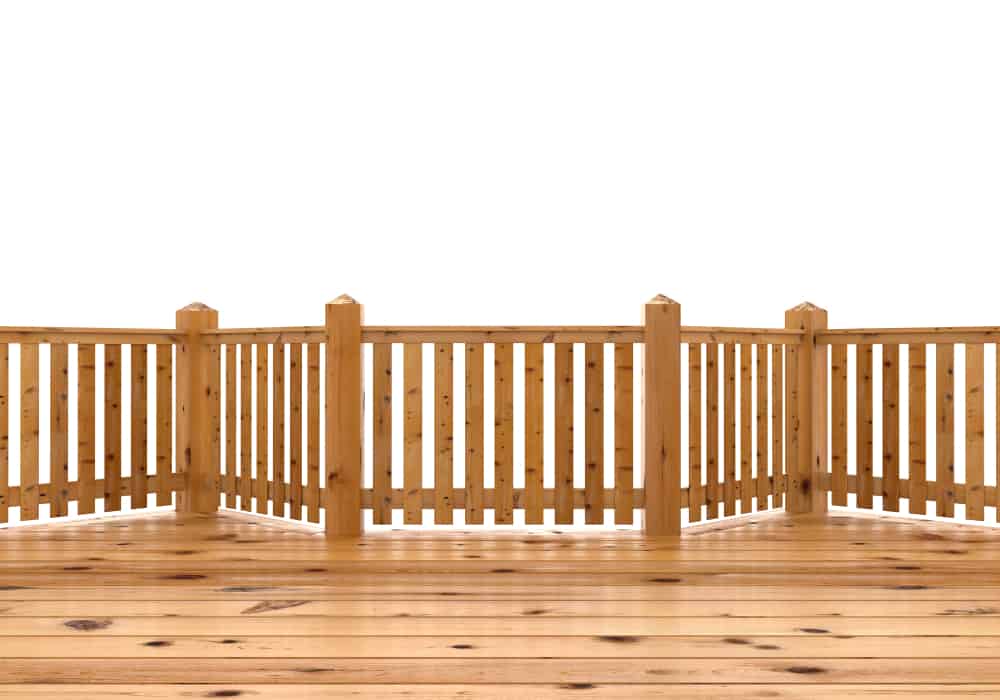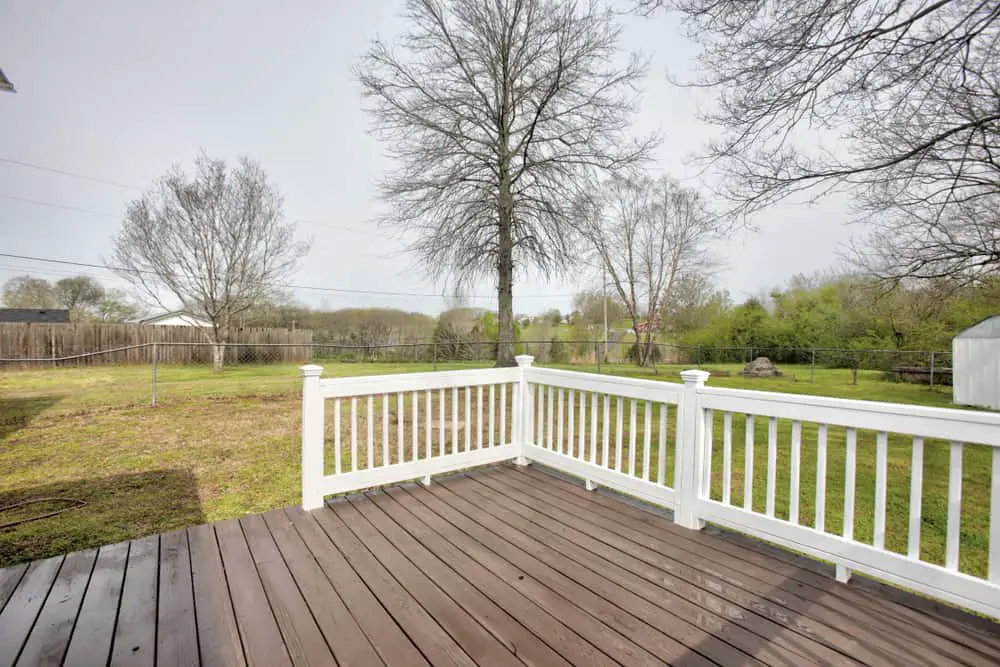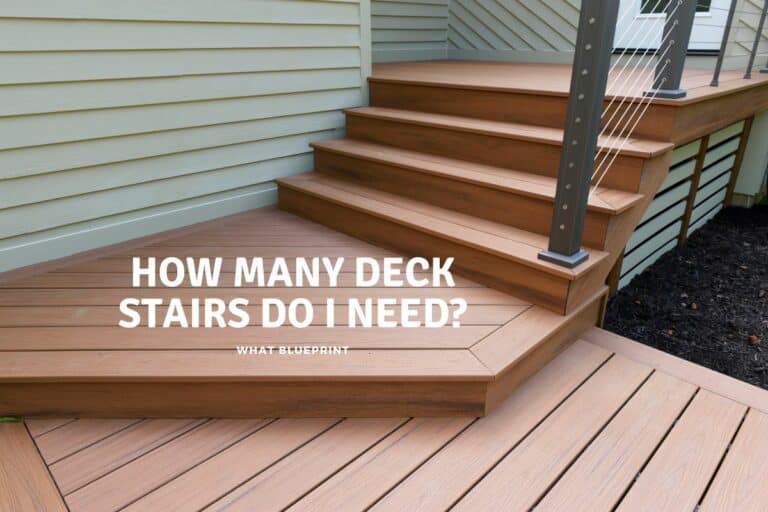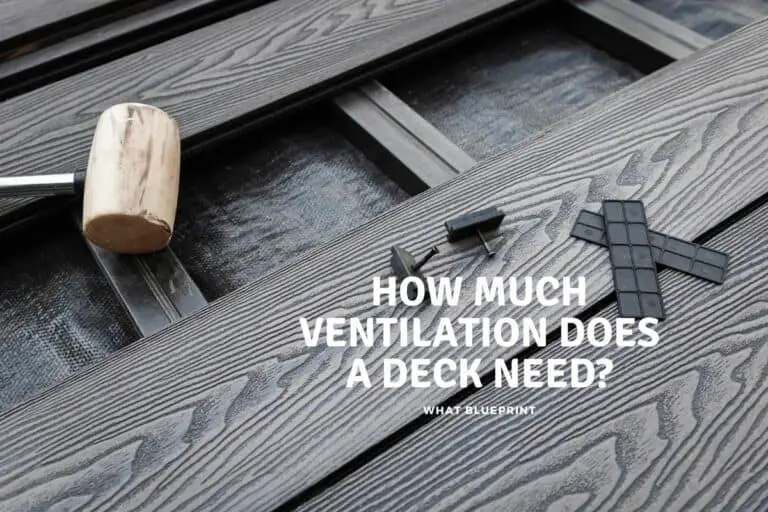How Far Can You Span A Deck Between Posts?
When you are building a deck, you need to take care of getting everything right the first time, or else you might have to do extensive repairs once inspectors start looking. There is a specific distance that your deck can be between posts, with several types of woods having specific distances they can span.
The ideal deck post spacing is eight feet, with some harder woods allowing up to ten feet at maximum. It is important to note that inspectors may require smaller spans between posts with longer spans requiring special permission and some strengthening to work properly.
There are several things that you need to be aware of when you will be designing and building a deck on your own. Several people have assumed that the deck spans can be as long as you want, but there are clear limitations to the lengths that specific pieces can be.
What Is The Maximum Distance Between Deck Posts?
The maximum distance between deck posts is around 15 feet, with the posts requiring that you need to have thicker wood the longer the span is. Most decks with longer spans are built on uneven ground, requiring that posts be spaced unevenly to ensure that the deck stays level.
We have seen several decks that have been built, with the first post being over ten feet away from the house but even other posts being within eight feet. This ensures that the deck is properly supported throughout, with the initial posts working with the support from the house itself.
If you have too far apart posts, the deck will start to become uneven over time, eventually becoming unstable when someone walks on it. Despite what many think, a deck should not shake and move when you are jumping on it; it should be as solid as any normal floor in a house.
How Far Can A Deck Span Without Support?
Decking cannot span further than 16 feet without support being provided with more support from posts and other triangulation systems. Further, when building a deck, the more posts are consistently spaced from each other, the longer it will be stable enough to continually be used.
It is important to remember that when you have your posts at 12 or even eight feet from each other, the entire deck can support more weight. This allows the deck to last much longer while also supporting anything from a hot tub to just a larger party.
We have seen several self-made decks that are spanned across distances too far, causing the joists and decking to warp. Even though the deck may feel stable, there are specific spots of the deck that becomes warped, causing people to trip when they first walk on it.
How Far Can A Deck Beam Extend Past A Post?
There is no set distance that a beam can extend past a post; instead, it is a recommended ratio that needs to be considered. Generally, 1/4 of the beam can extend past a post to prevent the full cantilever effect from simply pulling the nails or screws from the wood and shattering the wood.
A few people have failed to understand why this needs to be considered, creating a cantilever with their posts that quickly and aggressively cause the deck to be damaged. When a beam extends too far past the post, the pressure applied to it can cause the fulcrum effect.
This means that the pressure applied on the furthest point from where the post is multiplied, increasing the pressure applied to the nails and the wood. This is why 1/4 is the recommended maximum, as this prevents the fulcrum effect from happening at all.
How Many Posts Do You Need For A 12×16 Deck?
It is recommended to have around four posts when building a deck that is 12 feet by 16 feet, with a few extras to help spread the load evenly. The deck will be stable and resistant to winds and forces that push in on the deck from the side when built in this manner.
Further, it is recommended to have 6-inch by 6-inch posts for a deck of this size, as this will ensure that the post can weather the full brunt of the deck’s weight. However, if you do not have posts on this site, you can layer two 2-inch by 4-inch posts together to create a much stronger post.
Often you will see experienced deck builders layering pieces of wood together instead of just buying wood posts that are that exact size. This ensures that they can create posts that are the perfect strength and width without finding a way to transport the wood.
Where Do You Place Footings On A Deck?
Footings should always be installed below the frost line of your deck, preventing the footings from being overly damaged by moisture and snow. Further, we recommend researching the guidelines and standards for the state you are building in, as they will have more accurate guidelines.
It should be noted that when building a deck in a state or country that is dry and never experiences snow, the footings can be much lower. However, when dealing with snow, you need to consider the impact of layers of snow and frozen ground on the wood and the decking.
We’ve seen several people who ignore the effect that snow and ice will have in the long run on their footings. Causing them to rot and become much weaker within a few years than should happen, it is always best to find a way to keep the footings as dry as possible.
Should You Use 4×4 Or 6×6 Deck Posts?
While a 4-inch by 4-inch post will work for most decks, it has become common practice to at least have 6-inch by 6-inch posts for your deck. This is a change that has become common in most jurisdictions and standards authorities worldwide to ensure the strongest posts.
Many people will still use smaller posts as secondary support, but when using 6-inch by 6-inch posts, you can load a lot more weight onto the posts than normal. As the posts are strong enough to easily resist pressure from most sides, they can also be much longer than normal deck posts.
This is why decks that have to be several feet high will have thicker posts, with smaller gaps between each post. This ensures that the deck is fully supported and that the space under the deck can be used for storage or even as another space to entertain.

How Long Can Deck Railings Posts Be Apart?
The longest length that deck railing posts can be apart is around six feet, giving the railing the required strength to catch anyone leaning on them. Often the biggest challenge that inspectors face when inspecting railings is that home builders forget the function of the railings.
A deck railing is there to prevent anyone from falling over the deck, either through negligence or accident. Many decks fail inspection simply because the spacing of the deck railing is entirely off, or the railing is not nearly high enough to work as a proper railing for the deck.
Further, we have seen several deck railings posted entirely wrong, causing the deck railing to shift and move as someone leans against it. This is one of the clearest signs that a railing has not been built to code and usually causes the deck to fail inspection completely.
Does Having Double Joints Increase The Span Of A Deck?
To a certain extent, doubling a joint will increase the span of a deck by 25%; several limitations need to be considered. If you are building a deck that requires a span of more than 15-feet, you need to consider doubling the posts on both sides of the deck where the span will be.
Along with doubling the posts, you will need to double the main joints of the deck along the part where the increased span will be. Further, you will need an engineer to calculate how much everything is doubled to prevent overloading the joints, posts, and fastening equipment.
Few backyard builders of decks ever consider that the weight of the joints and the deck itself affect the way the deck is built. While doubling joints and posts does increase the span that can be crossed without a post, doing so adds a significant amount of weight, placing immense pressure on every joinery.
When Building A Deck, How Far Apart Are The Joists?
According to code, the joists of a deck can only be between 12-inches to 16-inches apart from each other, with the flooring being in the middle. This creates a solid floor for the deck and prevents winds and other forces from easily warping the overall shape of the deck.
We recommend considering this when building or designing a deck; creating a stronger deck that needs to span longer distances requires smaller spacing between joists. If the joists are between 10 to 12 inches, the weight will be more, but the entire structure of the deck will be much stronger.
Often, when homes are built on mountains, they have decks all along with the house, with the spacing between the joists being no more than 12-inches. This ensures that the deck can last as long as the house will, owing to the difficulty of building along mountainsides.
How Far Can A Deck Cantilever Over A Beam?
If you are building a deck that will cantilever over the edge of the initial deck or posts, the same calculation needs to be done when considering a single joist hanging over a post. The ideal space is only 1/4 of the total length of the beams that will be used to hang over the posts and joists.
We have seen entire sides of houses being lifted by decks built to cantilever longer than the entire deck length. While this may work, the continued weight and pressure applied by the deck across the length of the building create enough lift to essentially lift several tons.
When building a deck with an overhang, you need to consider this and get long enough joists to keep the ratio perfect. Further, adding support structure from the outer edge of the overhang to the nearest solid post will ensure that the cantilever effect is drastically reduced.
How Thick Should A Beam Be Between Deck Posts?
The main support beams should preferably be around 2-inches by 4-inches, with most builders preferring to use 4-inches by 4-inches when building larger decks. While using normal 2-inch by 4-inch beams as the intermediate joists for the entire deck length.
Doing this creates a technically over-engineered structure but means that the deck requires very little to no work in the future to keep it stable. The support beams will be able to carry much greater weight than normal while keeping the posts structurally joined together.
Further, we have seen several people who have used support beams smaller than 2-inches by 4-inches, only to have their entire deck go skewed with the first big wind. This happens because the beams are not strong enough to resist warping, instead easily bending when the right force is applied.
Conclusion
The best way to build your deck and determine how far the spans between each post will be to simply talk to a local inspector. They will be more than happy to provide you with all the things to look for and might even be able to tell you what woods are best for the soil and humidity in your area.
Please never build a deck without proper approval and planning; people die because of badly built decks!
References
- Deck Post Spacing: A Practical Guide (Plasticinehouse.Com)
- How To Calculate Deck Spans For The Ultimate Outdoor Hangout | Better Homes & Gardens (Bhg.Com)
- Deck Joist Sizing & Spacing | Decks.Com
- Recommended Beam & Joist Spans For Deck Framing (Sfgate.Com)
- How Far Apart Should Deck Railing Posts Be – Decksdirect
- How Far Can A Deck Beam Span? – Fine Homebuilding
- Deck Subframe Design Guidance –Tips For Laying A Decking Subframe (Qualitydecking.Co.Uk)
- Timber Decking Manufacturing And Installation| Timbermax
- TIMBERMANN – Home: Wooden Or Timber Decking Expert Installers In Pretoria. Suppliers Of Wooden Decks, Pool Decks, Patio Decking, Deck. Deck And Floor Maintenance And Renovations – Pretoria, Johannesburg & Gauteng – Including Pool Decks, Patio Decks & Timber Decking, Sun Decks, Deck, Decks, Decking, Timber Decking, Timber Decks, Timber Deck, Wooden Deck, Wooden Decks, Wooden Decking







